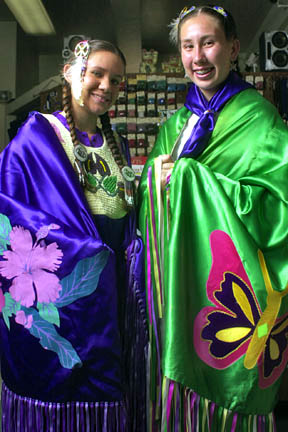
[ WEEKEND ]
You'll find bright-colored outfits at The Warrior Society Pow Wow, which takes place this weekend at Kapiolani Park. Find out what one of the sacred dances mean on Page 5. Above, Mike Allen does a dance.
Pow-wowing ’em
Legend says the jingle dance
cured a girl of her illness
in the '20s
Pow wows are recognized for their visual pageantry, but the meanings of the dances are often lost on observers who know little of Native American culture.
The fancy shawl dance is graceful, similar to a ballet and dancers -- cloaked in beautifully embroidered or decorated shawls -- need to be light on their feet.
Cassandra Tiger, 16, started performing the fancy shawl dance at the age of 4. "My dance is about imitating a butterfly," she said.
Warrior Society Pow Wow
When: 10 a.m. to 6 p.m. tomorrow and Sunday Where: Kapiolani ParkAdmission: Free
Call: Bill Tiger at 545-2119
"I wear a Hawaiian-print shawl that was made by my grandmother," said Tiger.
The costumes are intricate and can take a long time to complete. "It takes about a year to pull together an outfit. They are works in progress. As children grow, pieces need to be replaced. Some dancers take years to make their outfits," said Cady Ching's mother, Wendy Schofield-Ching.
Cady also began dancing when she was 4. Now 14, she says, "I like to dance because it's a good way to give back to the community."
Both girls will dance at the this weekend's pow wow, sponsored by the Intertribal Council of Hawaii, allowing Native American dancers and singers from various regions to celebrate and share their culture, music and food, including fry bread that is a staple, often topped with something sweet, such as honey or cinnamon-sugar.
Also featured will be head male dancer Shawnee Tiger (Muskogee); head female dancer Aleta Stevens (Cherokee); and master of ceremonies David Eagle Horse (Lakota).
Cherokee flutist Tommy Wildcat will also be appearing at the event. Wildcat was named Flutist of the Year at the Native American Music Awards for 2002 to 2003.
(Cady) is not of Native American descent but Bill Tiger let her join their group, said Schofield-Ching, owner of Native Winds.
"I like to educate people," said Bill Tiger, a member of the Muscogee Creek tribe who has danced at pow wows from Connecticut to California, and has been organizing local pow wows for the Intertribal Council for 13 years. His education mission includes giving talks at schools. "Many of the kids don't know that there are still Indians. Most of them think that they all got killed off by John Wayne," he said.
Cassandra Tiger, left, and Cady Ching perform the fancy shawl dance.
IN THE SOUTHWEST, dances survive as rituals. "They perform a corn dance to celebrate the harvest of the corn and a rain dance to pray for rain," said Tiger. Dances are not specific to any one tribe, though they are often associated with geographical areas, he said.
Among dances that will be showcased this weekend are the fancy shawl, traditional and jingle. The latter evolved in the 1920s when a young girl fell ill. The dance is revered as a healing dance. Legend says the Jingle Dress was given to Indian people in a vision. They needed to make a dress with jingle cones to heal her, explained Bill Tiger.
The resourceful tribes people used what they could. "The cones were made from snuff (chewing tobacco) can lids," he said.
The lid is carefully worked into a cone shape. A complete set is made up of 365 cones, one for each day of the year to represent medicine for each day of the year. Today, ready-made cones are available commercially, said Tiger. "But, a few companies still manufacture the old lids specifically to make the cones."
The cones swish together, creating a soothing sound, which at the time of the dance's creation cured the girl of her illness.
Today, people continue to perform the dance because they enjoy it. "Some young folks don't even understand the meanings," Tiger said.
As for the fancy shawl dance, Tiger said movements are compared to those of a butterfly because it is graceful dance in which the women spend a lot of dancing on their tip toes and spinning around.
The fancy shawl dance is one of the more contemporary dances performed, having originated 100 years ago.
The dances are not difficult, according to Tiger: "If you have rhythm, it's very easy. You just follow the beat of the drum. It is a steady beat, whether fast or slow." A lot of people say that the drum is the heart beat of the nation, he added.
"There are still a lot of people that carry on the culture," said Tiger. But, he said, it's getting harder to pass things down through the generations.
Lanny LaPlanta of the Lakota/ Navajo tribe performs a grass dance.
Cassandra Tiger, left and Cady Ching show off their shawls.
Click for online
calendars and events.





